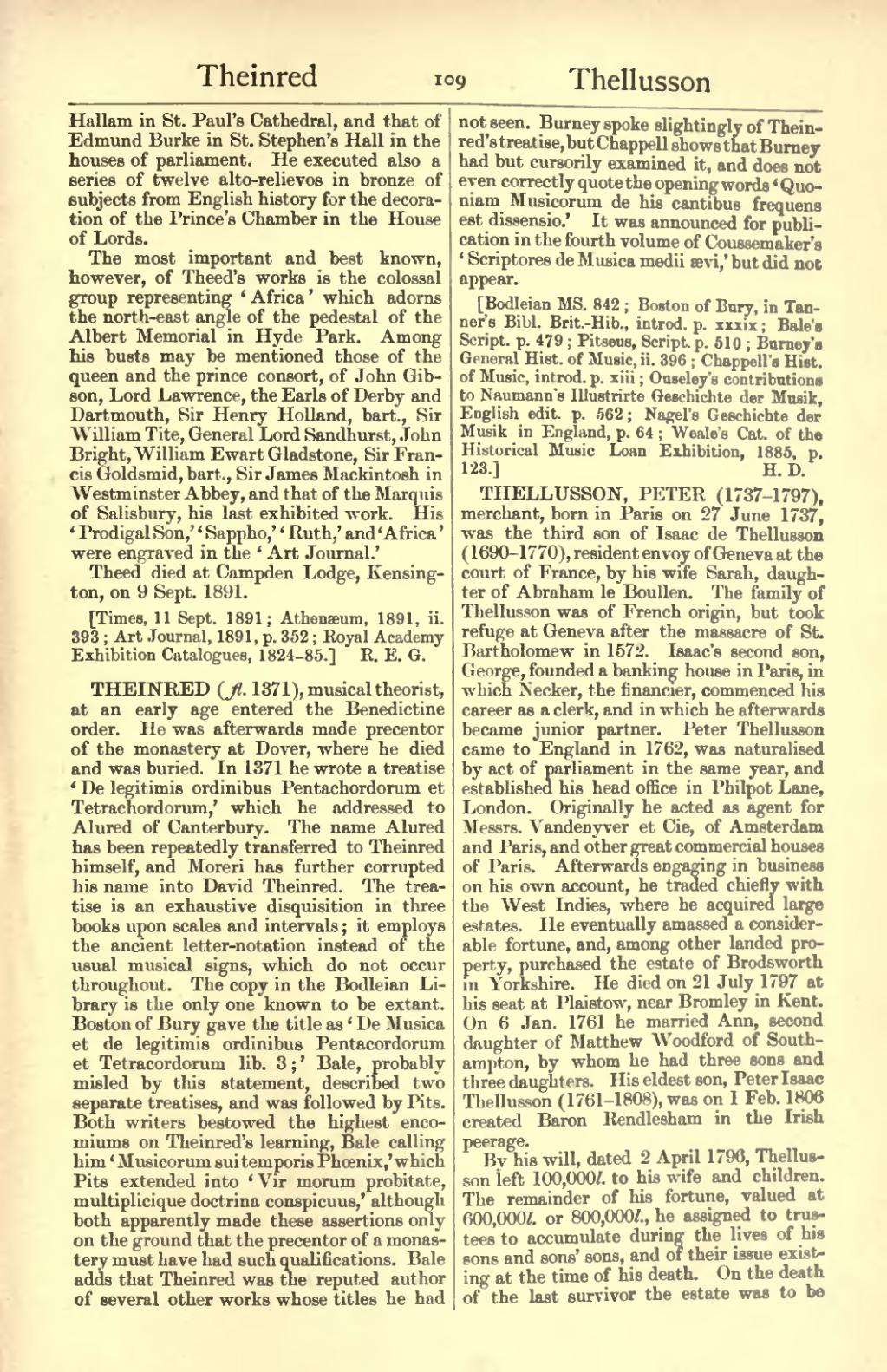Hallam in St. Paul's Cathedral, and that of Edmund Burke in St. Stephen's Hall in the houses of parliament. He executed also a series of twelve alto-relievos in bronze of subjects from English history for the decoration of the Prince's Chamber in the House of Lords.
The most important and best known, however, of Theed's works is the colossal group representing ‘Africa’ which adorns the north-east angle of the pedestal of the Albert Memorial in Hyde Park. Among his busts may be mentioned those of the queen and the prince consort, of John Gibson, Lord Lawrence, the Earls of Derby and Dartmouth, Sir Henry Holland, bart., Sir William Tite, General Lord Sandhurst, John Bright, William Ewart Gladstone, Sir Francis Goldsmid, bart., Sir James Mackintosh in Westminster Abbey, and that of the Marquis of Salisbury, his last exhibited work. His ‘Prodigal Son,’ ‘Sappho,’ ‘Ruth,’ and ‘Africa’ were engraved in the ‘Art Journal.’
Theed died at Campden Lodge, Kensington, on 9 Sept. 1891.
[Times, 11 Sept. 1891; Athenæum, 1891, ii. 393; Art Journal, 1891, p. 352; Royal Academy Exhibition Catalogues, 1824–85.]
THEINRED (fl. 1371), musical theorist, at an early age entered the Benedictine order. He was afterwards made precentor of the monastery at Dover, where he died and was buried. In 1371 he wrote a treatise ‘De legitimis ordinibus Pentachordorum et Tetrachordorum,’ which he addressed to Alured of Canterbury. The name Alured has been repeatedly transferred to Theinred himself, and Moreri has further corrupted his name into David Theinred. The treatise is an exhaustive disquisition in three books upon scales and intervals; it employs the ancient letter-notation instead of the usual musical signs, which do not occur throughout. The copy in the Bodleian Library is the only one known to be extant. Boston of Bury gave the title as ‘De Musica et de legitimis ordinibus Pentacordorum et Tetracordorum lib. 3;’ Bale, probably misled by this statement, described two separate treatises, and was followed by Pits. Both writers bestowed the highest encomiums on Theinred's learning, Bale calling him ‘Musicorum sui temporis Phœnix,’ which Pits extended into ‘Vir morum probitate, multiplicique doctrina conspicuus,’ although both apparently made these assertions only on the ground that the precentor of a monastery must have had such qualifications. Bale adds that Theinred was the reputed author of several other works whose titles he had not seen. Burney spoke slightingly of Theinred's treatise, but Chappell shows that Burney had but cursorily examined it, and does not even correctly quote the opening words ‘Quoniam Musicorum de his cantibus frequens est dissensio.’ It was announced for publication in the fourth volume of Coussemaker's ‘Scriptores de Musica medii ævi,’ but did not appear.
[Bodleian MS. 842; Boston of Bury, in Tanner's Bibl. Brit.-Hib., introd. p. xxxix; Bale's Script. p. 479; Pitseus, Script. p. 510; Burney's General Hist. of Music, ii. 396; Chappell's Hist. of Music, introd. p. xiii; Ouseley's contributions to Naumann's Illustrirte Geschichte der Musik, English edit. p. 562; Nagel's Geschichte der Musik in England, p. 64; Weale's Cat. of the Historical Music Loan Exhibition, 1885, p. 123.]
THELLUSSON, PETER (1737–1797), merchant, born in Paris on 27 June 1737, was the third son of Isaac de Thellusson (1690–1770), resident envoy of Geneva at the court of France, by his wife Sarah, daughter of Abraham le Boullen. The family of Thellusson was of French origin, but took refuge at Geneva after the massacre of St. Bartholomew in 1572. Isaac's second son, George, founded a banking house in Paris, in which Necker, the financier, commenced his career as a clerk, and in which he afterwards became junior partner. Peter Thellusson came to England in 1762, was naturalised by act of parliament in the same year, and established his head office in Philpot Lane, London. Originally he acted as agent for Messrs. Vandenyver et Cie, of Amsterdam and Paris, and other great commercial houses of Paris. Afterwards engaging in business on his own account, he traded chiefly with the West Indies, where he acquired large estates. He eventually amassed a considerable fortune, and, among other landed property, purchased the estate of Brodsworth in Yorkshire. He died on 21 July 1797 at his seat at Plaistow, near Bromley in Kent. On 6 Jan. 1761 he married Ann, second daughter of Matthew Woodford of Southampton, by whom he had three sons and three daughters. His eldest son, Peter Isaac Thellusson (1761–1808), was on 1 Feb. 1806 created Baron Rendlesham in the Irish peerage.
By his will, dated 2 April 1796, Thellusson left 100,000l. to his wife and children. The remainder of his fortune, valued at 600,000l. or 800,000l., he assigned to trustees to accumulate during the lives of his sons and sons' sons, and of their issue existing at the time of his death. On the death of the last survivor the estate was to be
